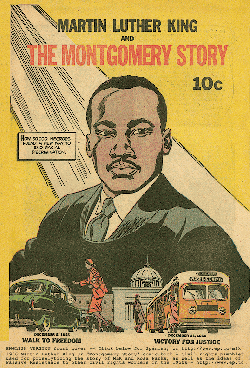 Sixteen pages front to back, Martin Luther King and the Montgomery Story sported a 10-cent cover price and featured 1950s mainstream studio style art when it went to press in December 1957. The publication date was barely a year after the bus boycotts in Montgomery had ended. The comic book represents a key example of long-overlooked efforts in the civil rights movement to use comic books, the thinner relatives of what we today call graphic novels, to educate and inspire young people.
Sixteen pages front to back, Martin Luther King and the Montgomery Story sported a 10-cent cover price and featured 1950s mainstream studio style art when it went to press in December 1957. The publication date was barely a year after the bus boycotts in Montgomery had ended. The comic book represents a key example of long-overlooked efforts in the civil rights movement to use comic books, the thinner relatives of what we today call graphic novels, to educate and inspire young people.
Efforts such as the creation of Martin Luther King and the Montgomery Story are particularly remarkable considering the time period in which they occurred. These civil rights comic books were created just a few years after the infamous “comic book hearings” held by the Senate Judiciary Committee’s Subcommittee to Investigate Juvenile Delinquency. During those hearings, comic books were portrayed as nefarious instigators of misbehavior through their depictions of violence and sexuality. Anti-comic book mania reached a fever pitch during the mid-1950s as librarians and teachers organized mass burnings justified as “purifying the minds of young people” from the corrupting influence of comic books. However, much of the violence and sexuality being depicted in comic books was simply a manifestation of the many violent shocks to the national consciousness suffered during World War II and heighted by the growing fears of nuclear war as the world entered the atomic age and the Cold War.
So it is quite remarkable that—at a time when such controversy dominated the national conversation—a pacifist organization called the Fellowship of Reconciliation (FOR) set out to create a comic book to tell the story of the Montgomery Bus Boycott and how nonviolence could be used to fight Jim Crow laws in the South. The project was spearheaded by Alfred Hassler, a longtime FOR member who possessed no particular love for the medium beyond his belief that it would be an effective method for reaching the widest possible audience. As the comic book took shape during the spring and summer of 1957, the story line developed to incorporate a greater focus on the role of Dr. Martin Luther King Jr., ultimately featuring his name in the title and his image on the cover. When the nearly finished script was sent to Dr. King, he flipped through the pages and offered his own edits, all of which were incorporated into the final version.
Serving as an origin story of sorts for Dr. King, as well as a primer on Mohandas K. (Mahatma) Gandhi and the nonviolent methods he advanced in India, Martin Luther King and the Montgomery Story was incorporated into FOR-led nonviolence workshops all across the American South. “The comic book was in the context of a larger curriculum as I taught it around the South and used it,” said Reverend Jim Lawson, an FOR field secretary during much of the late 1950s and later the key organizer of the Nashville Student Movement. “Part of its value was that it gave people a brief story of a very effective nonviolent campaign, something that they could refer to and memorize and study.”
More than 250,000 copies of Martin Luther King and the Montgomery Story were printed, and over time it has become the best-known example of comics created for use during the civil rights movement. But it was by no means the only one. Just a few years after the release of FOR’s comic book, the National Association for the Advancement of Colored People (NAACP) released at least two of its own with a similar goal in mind. One NAACP comic book, The Street Where You Live, was created by cartoonist Tom Feelings, best known for his illustrated book The Middle Passage: White Ships/Black Cargo. In The Street Where You Live, Feelings discusses similar themes of organizing, but focuses more on civic responsibilities and voting rather than on nonviolent civil disobedience. Another comic published by the NAACP, Your Future Rests...in Your Hands!, looks at economic and educational inequality as motivation for registering and voting.
In 1964, as efforts intensified throughout the South to register disenfranchised black voters, staff members of the Student Nonviolent Coordinating Committee (SNCC) in Alabama, including Courtland Cox and Jennifer Lawson, created simple, easily understood comic books to explain the registration and voting process to black voters whose lack of formal education meant that traditional brochures and word filled pamphlets were largely useless.
Lingering prejudices against comic books no doubt stalled serious academic inquiry. However, as comic books and graphic novels become ubiquitous, a new generation is uncovering the significant impact of comic books in the civil rights movement.
Aydin serves in Congressman John Lewis’ Washington D.C. office handling telecommunications and technology policy as well as new media. He is co-author, with Lewis, of the graphic novel March.

Develop your students skills for critically reading graphic novels and comic books with an eye toward social justice.

0 COMMENTS